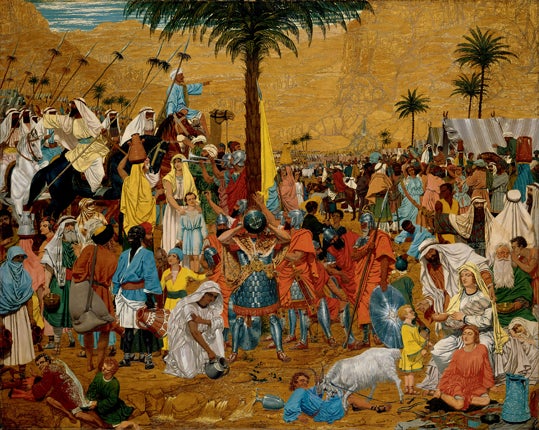Great works of the asylum
Richard Dadd's art flourished during his years incarcerated in bleak Victorian institutions for the murder of his father. Arifa Akbar reports

The artist Richard Dadd seemed destined for greatness when he took a life-changing tour across the Middle East at the age of 25: he had been admitted to the Royal Academy at the precocious age of 20 and was a leading light of The Clique, a Victorian circle of ambitious young painters.
So when he started behaving erratically in the last leg of the 10-month trip, his increasingly bizarre behaviour and the outlandish assertion that he was acting under the influence of the Egyptian god Osiris was dismissed as an acute case of sunstroke.
We now know it was the start of delusional episodes and psychotic behaviour that culminated in murder on 29 August 1843, when he lured his father, Robert Dadd, to a park in Kent, and stabbed him to death. He fled by boat to France, in such a confused and manic state that he later said he was on his way to assassinate Ferdinand I, Emperor of Austria.
He was arrested after attacking a French passenger with a razor and was brought back to England. It was this troubled night, on 30 August 1843, that was to be his last as a free man. He spent the rest of his years incarcerated, until his death in 1886. Yet he was to become a great and influential painter while held in Britain's notorious psychiatric prison, Bethlem (commonly referred to by its nickname of Bedlam), and later in the newly built Broadmoor in 1864.
Dadd's life is now being revisited with a book, a play and an exhibition. Richard Dadd: The Artist and the Asylum, by Nicholas Tromans, examines his hospital case notes, recently released and hitherto unpublished. The notes record his relationship with his psychiatrists (some which bordered on friendship), the role these doctors played in his artistic life and the changing nature of his psychiatric condition. It is the first comprehensive, illustrated biography since the Tate Gallery's 1974 exhibition catalogue and it looks at the life of an artist who was painting surrealist imagery and alternative worlds, including dream figures, fairy creatures and demons.
And tonight, at London's Finborough theatre, Steve Hennessy's play The Demon Box will dramatise Dadd's life-changing trip to Egypt, where his delusions became grander and more baroque. Popular regard for his art then was largely eclipsed by his "madness" in an age when schizophrenia had not been identified. More than a century after his death, he is acknowledged as an important British artist whose work hangs in the British Museum and the V&A.
Dadd's subject matter did not fit tidily into an art movement, neither in his day nor in the decades after his death: often featuring fantastical, quasi-human creatures from fairyland, it was dismissed as arcane or escapist. It was only in the 1960s when the academy began its reappraisal that he was acknowledged as a surprisingly contemporary and inspirational painter. Artists paid homage, the writer Angela Carter drew out his work's eroticism in a radio play, Come Unto These Yellow Sands, featuring skimpily dressed fairies, and the rock band Queen wrote a song, The Fairy Feller, based on his most famous painting.
Tromans says Dadd's prison casenotes reveal that his jailers became his only audience and acted as patrons, encouraging him to continue producing artworks.
Dadd was born in Chatham, Kent, in 1817, one of seven children, and was raised by his chemist father after his mother died. Dadd's talent for art was clear as a child and before he was even in his twenties, he became a key member of The Clique, artists who would later become the stars of Victorian genre painting, including William Powell Frith and John Phillips.
His tour across Europe, Egypt and the Arab countries west of Iraq, aligned him to an Orientalist movement. It was towards the end of this trip, when he was travelling through Rome and Naples, that his colleague noticed personality changes. He began talking about religion with an outspoken fervour, turning against Christianity and claiming he was being watched by someone attempting to injure his health. His reason for killing his father would be based on this fascination with religion and he would tell his doctors that he was instructed to kill byancient deities.
His Bethlem casenotes record that he gorged himself until he vomited and then returned to the meal; and "for some years after his admission, he was considered a violent and dangerous patient, for he would jump up and strike a violent blow without any aggravation, and then beg pardon for the deed". Today, medical experts might recognise Dadd's illness as a textbook case of schizophrenia. Yet despite his condition, he continued to paint with vigour. It was in Bethlem that many of his masterpieces were created, including the celebrated The Fairy Feller's Master-Stroke.
Dadd's was a small, sad, isolated life, spent in the confines of prison cells. Yet he was able to harness a magnificent, other-worldly imagination that lives on in his canvases today.
The Demon Box is at the Finborough Theatre, London SW10 (020 7244 7439) to 1 October. Richard Dadd: the Artist and the Asylum by Nicholas Tromans is published by Tate Publishing. An exhibition of Richard Dadd's work from the Bethlem Royal Hospital Collection is at the Orleans House Gallery, Twickenham (020 8831 6000) to 2 October
Subscribe to Independent Premium to bookmark this article
Want to bookmark your favourite articles and stories to read or reference later? Start your Independent Premium subscription today.

Join our commenting forum
Join thought-provoking conversations, follow other Independent readers and see their replies